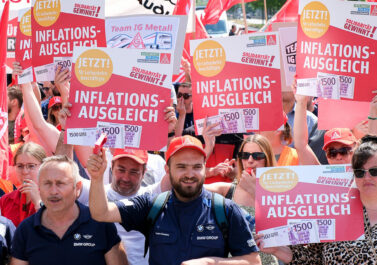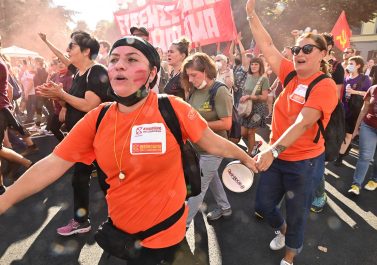
A short report from our comrades in Brazil…
Covid cases are exploding in Brazil. This March, the country is living through the highest peak of daily deaths since the pandemic started. There is a mutation from the state of Amazonas that is quite a bit more dangerous and might be resistant to some vaccines. Hospitals are collapsing in many states. Within this context, the current rate of vaccination is very slow and the general social situation is much worse than in 2020. The economic situation is much harder: unemployment is very high, the cost of living is rising and since December, the government is no longer paying the Emergency Basic Income. So, many workers go out onto streets anyway, trying to survive by undertaking informal activities (delivery, hawking, etc.) [1].
Amid the general rise in prices, one price hike in particular is critical: the fuel prices. Even though Brazil produces oil, since 2016 the country has adopted a policy of price parity with imported oil, so the fuel cost is exposed to the flutuations of the dollar exchange rate. That’s why the gasoline price has increased 6 times this year. At the beginning of the year, truckers’ groups and unions called for a strike against fuel prices on February 1st. The strike failed: there were around 20 attempts to blockade across the country, which were repressed by the police, and strikers faced a massive counter-propaganda campaign through WhatsApp. However, this call had an important political impact as it broke Bolsonaro’s support in his most important ‘syndicalist’ base, the truckers [2].
However, the truckers’ assembly did manage to influence many ‘uber-ised’ car/motorcycle/scooter drivers. Since then, app couriers and app car drivers have been protesting almost every day in different cities. Car drivers have a specific demand against promotional fares (“Uber Promo” and “99 Poupa”) that pay very low. The fuel price is a demand that unifies truckers, car drivers and motorcycle couriers nationwide. In some places these sectors are merging their protests. Many Uber drivers and self-employed truckers see themselves in a dead-end situation and are deciding to abandon the job because costs are so expensive and the fares so low that, at the end of the month, they’ve barely made enough money to make it worthwhile. Most of those protests – either from couriers, app drivers or truckers – are being organized through WhatsApp groups, from which, ocassionally, leaders emerge. Group administrators are often assuming the role of representatives of these groups. The trade unions and associations who, with their sparse and scattered existences in unregulated sectors, have been largely absent from these online groups.
In terms of tactics, most of these protests are caravan demonstrations in the cities. Sometimes there are attempts to block highways and Petrobrás [3] distribution centres, but this kind of action is quickly repressed by military police and even by the traffic police (that give out vehicle penalties). Another interesting form of struggle is to crowd gas stations and pay just R$1,00 to fill the petrol tank (something that supposedly causes economic losses to the seller). Also, in some regions of São Paulo couriers have blockaded shopping centres and fast food stores, preventing deliveries from being made, and demanding higher fares and promotional fares in the zone. These tactics have a clear reference point – the accumulation of experiences from previous struggles. Most of these protests were organized by groups of couriers who has also actively participated in 2020’s ‘App Brakes’ struggles, which were national couriers’ strikes on the 1st and 25th of July last year, and where blocking deliveries was central to their repertoire [4].
At the same time, as public health systems collapse, local governments try to decree lockdowns – in disagreement with the federal government as Bolsonarism is against quarantine measures. (Up until now, ’lockdown’ in Brazil has meant restrictions to businesses, but there are almost no curfews). Very often, these motorised workers’ mobilisations also rail against local quarantine measures. It means that, sometimes, informal workers’ mobilisations are mixed up with local bosses, whose primary interest at this moment is to keep businesses running.
Bolsonaro seems to be very aware of this situation. So he is trying to intervene in Petrobrás and reduce federal taxes on diesel. This intervention caused the stockmarket go wild against him. However, none of this impacted on real fuel prices, and since the intervention there have even been more price increases. During March, there have been lots of Uber drivers, app workers, truckers and antilockdown protests happening everyday around the country. And sometimes they are converging, although there are internal debates and conflicts (some couriers posit that the lockdown isn’t necessarily bad to them, if the demand for deliveries keeps growing). Some couriers also refuse to demonstrate alongside with the restaurant owners, pointing out that these bosses are the same who pay them low.
Politically, all of this is might be closer to a right-wing spectrum, and until now, there has been almost no left organisation connected to these struggles [5]. There are clearly proletarian tendencies in the movement, and that’s where our efforts must focus.
Some of those mobilisations are being registered on @tretanotrampo Instagram page.
Notes
[1] This situation is not completely new. One year ago, we pointed out that Bolsonaro’s anti-lockdown discourse wasn’t simply about answering the demands of the small bosses who support him, but also appealing “to workers who depend on small gigs to survive and who do not see anything but misery when facing the pandemic” (see, in English, the article: https://passapalavra.info/2020/04/130921/). However, during 2020 the Emergency Basic Income had a decisive role in containing this dangerous tendency as it provided a safety net for a huge mass of informal workers.
[2] In 2018, truckers paralysed the country in protest against the price of diesel. (This was a mix of strike and lockout, but a result of the material composition of this sector). This movement was really radical, ignoring the attempts of union representative to negotiate on their behalf and causing shortages in many parts of the country. On the other hand, striking truckers raised the banner of a “military intervention” against Michel Temer’s government, paving the way to Bolsonaro’s ascension at the end of that year.
[3] Brazilian national oil company, half state-owned, half private.
[4] For some English subtitled footage of the App Brakes protests, see:
https://www.youtube.com/watch?v=t9pgI4NGNzs.
[5] With only one exception: the oil workers unions that are campaigning against the policy of price parity, and so organise actions where they sell petrol to app workers at the production cost.



